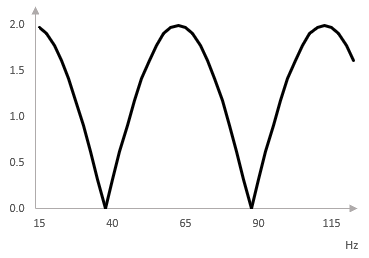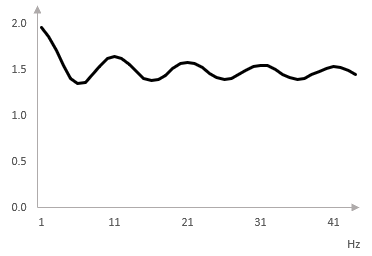A flanger is a sound effect that combines the original signal with a slightly delayed, but not decayed repetition of the signal and varies the amount of delay.
Example of a flanger and sound sample
See Orinj Flanger to hear a sound sample before and after a flanger.
Magnitude response of a short delay
Combining the original signal with a slightly delayed repetition of itself is a slapback delay or a comb filter. Each frequency in the original signal is delayed by the same amount of time, but that same amount of time means a different phase for each frequency.
When the original signal is combined with the delayed signal, because of the changes in phase, some frequencies are s reduced amplitude, while others increase. That is, the magnitude response of the result has notches.
The following is the magnitude response of a short delay that combines the original signal with a delay in the original signal of 20 ms.

Magnitude response of a flanger
A flanger slowly varies the amount of delay. The following is the same graph, but when allowing a change in the delay between 18 ms and 22 ms once per second (at 1 Hz).

This graph will not change when the delay changes. This graph will only change significantly if we change how fast the delay oscillates. This graph will change slightly if we change the size of the oscillation in the delay.
The magnitude response of the flanger is not as interesting as the magnitude response of the comb filter.
Pitch shifting in the flanger
The variations in the delay speed up or slow down the delayed signal. This will change its pitch.
Suppose that the delayed signal in the graph above starts with a delay of 20 ms and we are using a sampling rate of 500. In a quarter of a second, the flanger should process a quarter of the sampling rate, which is 125 samples. However, in the same quarter of a second, the delay decreases to 18 ms. To decrease the delay, the flanger must process an additional 10 samples of the delayed signal.
Thus, in the time it takes to process 125 samples of the delayed signal, the flanger processes 135 samples, which is equivalent to increasing the pitch to about 1.08 or about 11 cents. The pitch similarly decreases when the delay increases.
This variation in pitch is similar to a vibrato.
Flanger parameters
The following are some typical controls in a flanger.
- Rate, speed, or LFO: The rate describes how fast the delay of the flanger oscillates.
- Width: The width describes how far the delay swings (between shorter and longer).
- Manual: This is the delay center.
- Regen: This is a feedback control that describes how much of the output is fed back into the input.
Add new comment